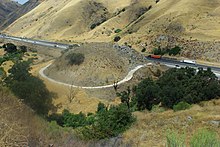Grapevine, California
This article needs additional citations for verification. (October 2013) |
Grapevine | |
|---|---|
 The Grapevine, looking south | |
| Coordinates: 34°56′30″N 118°55′48″W / 34.94167°N 118.93000°W | |
| Country | United States |
| State | California |
| County | Kern County |
| Elevation | 1,499 ft (457 m) |
| ZIP code | 93203 |
| Area code | 661 |
| Official name | Top of Grapevine Pass[2] |
| Reference no. | 283 |
Grapevine is an unincorporated community in Kern County, California, at the southern end of the San Joaquin Valley.[1] The small village is adjacent to Interstate 5 and consists mainly of travelers and roadside services.
At an elevation of 1,499 feet (457 m),[1] the community is located at the foot of a grade known as The Grapevine that starts at the mouth of Grapevine Canyon, immediately south of the community, and ascends the canyon to the Tejon Pass in the Tehachapi Mountains via Interstate 5 (formerly U.S. Route 99). The village and grade are named, not for the once-winding road known as the Grapevine that used to climb the steep mountain canyon, but for the canyon it passed through with its wild grapes that still grow along the original road.[3] Its Spanish name was La Cañada de las Uvas, i.e. Grapevine ravine.[citation needed]

Before the road was straightened and widened during 1933–34 by the three-lane Ridge Route Alternate (US 99), the Grapevine was infamous for its high accident rate.[4] There are escape ramps branching off both sides of the downward part of the road for heavy trucks whose brakes fail on this five mile long, 6% grade, 1600 foot ascent - and now straight - grade.[citation needed] Occasionally the road is still closed due to snowfall and slides during winter storms. It has also been closed for fire and, in October and December, 2015, mudslide.[citation needed] As the Grapevine is the major route between Central and Southern California, any closure is a major disruption to traffic along the West Coast.[citation needed]
The top of the Grapevine is registered as California Historical Landmark #283, where Don Pedro Fages passed through in 1772 during his explorations through California.[2]
In 1955, Charlie Ryan wrote and performed a popular song known as "Hot Rod Lincoln", about a teenager who races his souped-up Lincoln against a Cadillac up the Grapevine hill. While Ryan never drove up the Grapevine, this song was inspired by his own experience racing a friend between Coeur d'Alene and Lewiston, Idaho.[citation needed] The song was an answer to the 1951 song "Hot Rod Race" by Arkie Shibley, referring to the same stretch of road in central California.[citation needed]
The ZIP Code is 93243, and the community is inside area code 661.[citation needed] A post office operated at Grapevine from 1923 to 1960.[5] The community of Wheeler Ridge lies three miles north of Grapevine on Interstate 5, with Lebec nine miles south.
See also
- Ridge Route, the former route currently bypassed by Interstate 5
References
- ^ a b c U.S. Geological Survey Geographic Names Information System: Grapevine, California
- ^ a b "Top of Grapevine Pass". Office of Historic Preservation, California State Parks. Retrieved 2012-10-07.
- ^ Scott, Harrison Irving (2003). Ridge Route: The Road That United California. Torrance, California: Harrison Irving Scott. pp. iii–v. ISBN 0-615-12000-8.
{{cite book}}: Invalid|ref=harv(help) - ^ Ridge Route
- ^ Durham, David L. (1998). California's Geographic Names: A Gazetteer of Historic and Modern Names of the State. Clovis, Calif.: Word Dancer Press. p. 1042. ISBN 1-884995-14-4.
External links
- The Mountain Enterprise - local newspaper serving readers of Grapevine and some other small communities.



